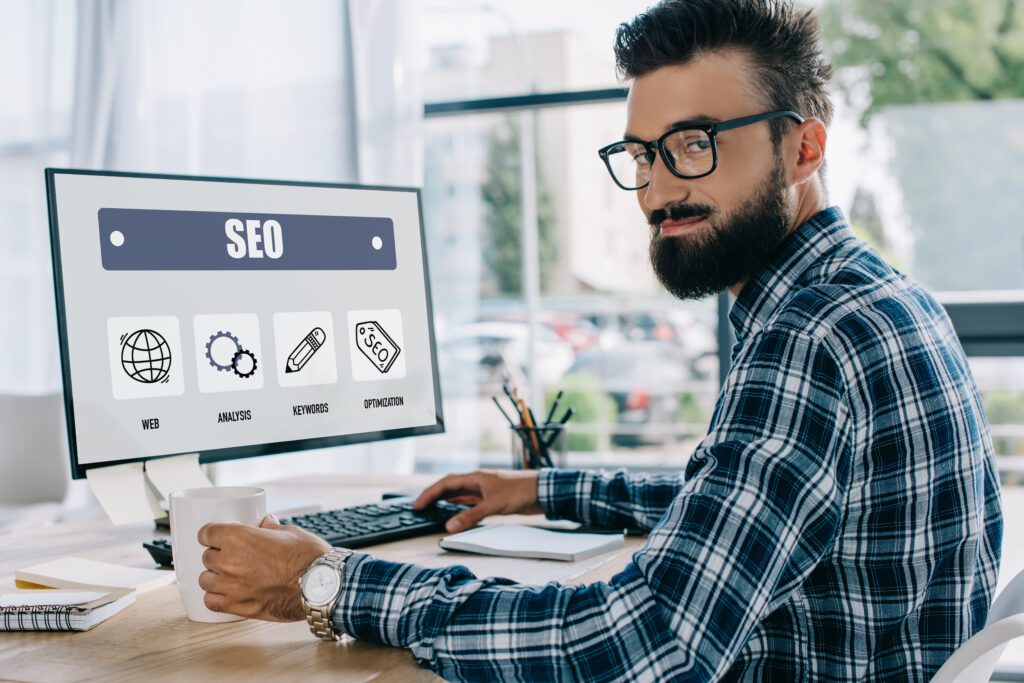Subtotal $0.00
Would you like to know Most Vital Website Essentials? In this modern digital era, especially in 2024, a website now is a business success machinery. Yet, it is important to be aware that a web page that meets every requirement would only be considered a success.
A step-by-step procedure of the top 10 essential requirements will be presented in the present guide to you. In the next section, we will elaborate on the factors that encompass design specially made for users and AI-based personalization that can significantly improve the efficiency of your website.:
• Enhance user experience
• Boost your search engine visibility
• Convert visitors into loyal customers
• Build trust and credibility
Whether you’re a small business owner or a seasoned entrepreneur, this comprehensive roadmap will help you navigate the ever-evolving digital world. Ready to transform your online presence and meet the rising expectations of internet users? Let’s dive in and discover how to make your website a powerful tool for business growth in 2024.
Revolutionizing Your Online Presence: 10 Essential Website Features for 2024
Understanding the Importance of Revolutionize Your Business Online
In this era of technology, a strong website is not something left but a need of enterprises (enterprises). The World Wide Web is the most suitable repository of data, consumer behavior, and brand communication and has become a source of data for more than 4.9 billion people who are active on the Web.
“Imagine that: above 4.9 billion people worldwide are on the Internet. This is a staggering 62% of the planet’s population!”
The Web is where your potential customers are; they are finding products similar to what you are offering. If you do not appear prominently on the web, you will be silent among potential customers who are there.
Think about it:
Can you remember the last time you used a directory to find a company? It’s probably long ago. You might rather have pulled out your phone and just looked up whatever you needed quickly.
You may feel that this is the only way your customers think and act.
A well-considered site is not just a fancy alternative to having a physical store available to customers around the clock. It is the place where you showcase your products, tell your brand story, and make connections with your target market.
But a mere web portal is not enough. The real key lies in creating a portal that will grab the attention of potential clients, keep them involved, and finally, will earn their purchase.
With 2024 here, customers are awaiting the next level of experience. They need quick, spotless, and nicely done for the phone design.
You could easily cover the current shortcomings and expose a completely new facing or concept of yourself to the market. Do you think you are ready for that?
User Experience: The Foundation of Successful Websites

Your online space’s success heavily depends on the way people use it. It’s not just about appearances – it’s about the general impression you give them when they visit your website to revolutionize your business online.
Let’s even talk about an example that is out of day and consider: You come into a shop. The paths are dirty, the signs are not understandable, and the workers do not help you. You’d probably leave without buying, wouldn’t you?
Pages on websites work similarly.
When the time comes and your visitors really like your site, they spend more time on it than they planned to. They even check out more products, and, likely, they will finally make a purchase.
However, what are the factors that make a website the most enjoyable to use?
It’s a combination of factors:
– Easy navigation
– Fast loading times
– Clear, readable content
– Intuitive design
– Mobile responsiveness
Let’s dive deeper into two crucial aspects of user experience:
Intuitive Design and Navigation
Think of your website’s navigation as a roadmap. It should guide visitors effortlessly to where they want to go.
Here’s what makes navigation intuitive:
– Clear menu labels
– Logical page hierarchy
– Search functionality
– Breadcrumb trails
For example, Amazon’s mega-menu allows users to quickly find products across numerous categories. It’s comprehensive yet easy to use.
Remember, every extra click a user has to make is an opportunity for them to leave your site. Make their journey smooth and straightforward.
Mobile-First Approach
As time passes by and technology keeps on advancing to revolutionize your business online, the habit that people are developing nowadays, which is the usage of phones for web browsing, is still growing. It is worthwhile knowledge that about fifty-five percent of the entire online traffic around the world comes from handheld gadgets.
The beginning of your design process has to be with the mobile-first. This points out how your website appears on a small screen and then expands to bigger displays.
The way it is done allows the online space to work equally well on any device regardless of what people use to view it. Besides, it will look good always.
Key elements of a mobile-friendly layout include:
– Responsive design
– Large, easily tappable buttons
– Simplified navigation
– Optimized images
Take Airbnb’s mobile site as an example. It’s clean, easy to navigate, and offers the same functionality as the desktop version.
SEO Optimization: Boosting Your Visibility

Think about this: You’re in the city where a new restaurant is just opening. The food is nice there, and they recreate the feeling of Gita well. But the problem is that it’s hiding on a small street without any advertising. Who will be your customers?
Imagine you have created a wonderful web page but it’s not that easy to see for the search engines. Only when it is listed among the others, will they know if it is you.
This is the place where you have to think about making your website to be easily discovered.
It is one of those things that you can do in order to get higher placement on the search engines
Your web space gets improved by adding more content, images, and pages with what people look for on Google, Bing, and other search engines if you want to revolutionize your business online.
Your website appearing mostly in the searches will let you grab the attention of possible soon-to-be customers and the ones who are already.
Yet, the process of making your site easy to find really is. What does it imply?
Search engines use complex algorithms to determine which pages should rank for which keywords. These algorithms take into account factors like:
– Relevance of content
– Website loading speed
– Mobile-friendliness
– Quality of backlinks
– User experience
By optimizing these elements, you can improve your chances of ranking higher in search results.
Content Strategy for SEO Success
Content is king in the world of SEO. High-quality, relevant content not only attracts visitors but also signals to search engines that your site is a valuable resource.
Here’s how to create a winning content strategy:
1. Keyword Research: Identify the terms your target audience is searching for.
2. Create Valuable Content: Write informative, engaging content that addresses your audience’s needs.
3. Optimize On-Page Elements: Use keywords in your titles, headers, and meta descriptions.
4. Regular Updates: Keep your content fresh and up-to-date.
For example, Moz, a leading SEO software company, regularly publishes in-depth guides and blog posts on SEO topics. This not only helps them rank for relevant keywords but also establishes them as an authority in their field to revolutionize your business online.
Remember, SEO is not a one-time task but an ongoing process to revolutionize your business online. As search algorithms evolve and user behavior changes, your SEO strategy should adapt too.
Responsive Design: Adapting to All Devices
Imagine that you are trying to read a full spread of a newspaper through a peep hole. It’s unpleasing, right? Well, that’s what folks feel like when they use a web space that is big screen-oriented on their mobile phones.
A website that adapts to different screens is no longer just a good thing to have. It’s no longer an option but a must.
Mobile phones, which are mostly used for online surfing, should be designed so that they are easily accessible and enjoyable to use on any device, with the smallest ones like, for example, the cell phone to the largest ones like a computer screen.
However, what is it that we have in our thoughts when we talk about such kinds of websites that can mold up to fit on various screens?
It’s an approach to web design that makes your web pages render well on a variety of devices and window or screen sizes. It’s about creating a flexible, fluid website that adapts to the user’s device.
Here’s why responsive design is crucial:
1. Improved User Experience: No more pinching and zooming to read content.
2. Better SEO: Google favors mobile-friendly websites in its rankings.
3. Increased Conversion Rates: Easy-to-use sites lead to more conversions.
4. Cost-Effective: One site works across all devices, reducing development and maintenance costs.
Take Dropbox’s website as an example. Whether you’re viewing it on a smartphone, tablet, or desktop, the experience is seamless. The layout adjusts, images resize, and navigation simplifies on smaller screens.
To implement responsive design:
– Use flexible grids and layouts
– Implement flexible images and media
– Utilize CSS media queries
Remember, in 2024, a non-responsive website is like a store with a “Closed” sign. Don’t miss out on potential customers because your site doesn’t work on their device of choice.
E-commerce Capabilities: Turning Visitors into Customers

If you think of a physical store that just opens for one hour every day, won’t you feel that it is so weird? But that’s exactly what happens when a company doesn’t include e-commerce functionalities on its website to revolutionize your business online.
In the digital era, e-commerce has become something that big retailers use only. It has transformed into a necessary tool that firms of any size rely on to have the sale of their products and services without making any interruption 24-hour-time throughout the whole year.
While we are passing through 2024, every customer has perceived what online the market has to offer at the click of a button, and they are prepared to have a bite of the cake. It does not matter what you offer, be it handmade accessories or e-commerce equipment. Your business team can still assist you in achieving this consumer’s anticipation which will eventually result in heightened output regardless of the other factors.
Here’s why e-commerce is essential:
1. Expanded Reach: Sell to customers beyond your local area.
2. Increased Sales: Your store is always open, even when you’re sleeping.
3. Lower Overhead: No need for a physical storefront or additional staff.
4. Data Collection: Gain valuable insights into customer behavior and preferences.
But what does a good e-commerce platform look like to revolutionize your business online?
Take Shopify, for example. It offers a user-friendly interface, secure payment processing, inventory management, and even marketing tools. Small businesses like Gymshark have used Shopify to grow into global brands.
Key features to look for in an e-commerce platform:
– Secure payment gateways
– Mobile-friendly design
– Product catalog management
– Shopping cart functionality
– Order tracking
Remember, your e-commerce capabilities should be seamlessly integrated into your website. A clunky, difficult-to-use online store can drive potential customers away faster than you can say “shopping cart abandonment”.
Social Proof and Testimonials
At some of the restaurants I visited, I witnessed a perplexing situation; Loyalty to the first store in the line is so high that people choose to wait, even though neighboring places have free tables. This action is a good example of the principle of social validation when it is applied to revolutionize your business online.
As far as our digital engagements are concerned, social validation is an equally important factor. In the same way, that a crowded restaurant entices customers, virtual reality communicates with buyers
impressively through the website by focusing on the brand’s identity as a trustworthy and innovative business.
You might wonder, “How can I cultivate this social validation on my digital platform?”
The best solution to the question is by the use of evidence-based client testimonials and feedback.
These factors will prove to be the most valuable tools for your presence in the web. They provide real and sincere experiences with people who have used the product. These testimonials, which are very realistic and can sway buyers, play a key role in potential buyer’s decision-making.
Consider these stats:
– 92% of consumers read online reviews before making a purchase
– 88% of consumers trust online reviews as much as personal recommendations
That’s the power of social proof!
Here’s how to effectively use testimonials and reviews:
1. Showcase Diverse Feedback: Include testimonials from various customer types.
2. Use Real Names and Photos: This adds authenticity.
3. Include Specific Details: “Increased our sales by 50%” is more powerful than “Great service!”
4. Update Regularly: Fresh testimonials show your business is consistently delivering value.
Take Airbnb as an example. They display host and property reviews prominently, allowing potential guests to make informed decisions based on others’ experiences.
Don’t forget about other forms of social proof:
– Customer ratings
– Social media followers count
– “As featured in” media mentions
– Client logos (for B2B businesses)
Remember, in the vast library of user-generated content that is on the internet, let your satisfied customers tell your story. Their words can be your most powerful marketing tool to revolutionize your business online.
Clear and Compelling Calls to Action (CTAs)
I remember being at a music concert where a strange thing happened. The performers finished their songs but as obsolete as it may sound, they vanished from the stage without saying a thing, The audience was so perplexed and uncomfortable, that nobody knew what to do next.
This is how people might feel when they are on a website and do not have clear information to follow. They are feeling lost, not sure what move is to be made or why they are there at all.
Online, we specify some particular items to guide our customers. These functions work as virtual signposts, showing people where we anticipate them to act. This can mean purchasing, subscribing to our updates, or asking for more information about our services to revolutionize your business online.
Through those guiding means, we not only secure the online visitors with trouble-free walkways, but also leave them with joyful memories of concerts that were clear and filled with understandable information,
Here’s why CTAs are crucial:
1. They provide direction to visitors
2. They increase conversion rates
3. They improve user experience
4. They help measure marketing effectiveness
However, not all CTAs are created equal. A compelling CTA should:
– Stand out visually
– Use action-oriented language
– Create a sense of urgency
– Clearly communicate value
Let’s look at some examples:
– Netflix’s “Join Free for a Month” CTA is clear, action-oriented, and emphasizes value.
– Evernote’s “Sign Up for Free” button stands out with its green color and prominent placement.
– Airbnb’s “Start your search” CTA on their homepage invites users to begin their journey immediately.
Remember, different pages may require different CTAs. Your homepage might have a “Learn More” button, while a product page could feature a “Buy Now” CTA.
Here are some tips for creating effective CTAs:
1. Use contrasting colors to make your CTA buttons pop
2. Keep the text short and punchy (ideally 2-5 words)
3. Place CTAs where they’re easily visible (above the fold is often best)
4. A/B test different versions to see what works best
Pro tip: Consider using marketing automation tools to personalize CTAs based on user behavior or demographics. This can significantly boost your conversion rates.
Integrating Artificial Intelligence for Personalization

There are instances that we can hardly forget. One of the times that I still remember and love from that place I preferred to have my coffee is when I was in there, the seller who is the waiter, greeted me pleasantly by my name and then started to make my regular order without my request. I didn’t have to say anything but the fact that I got this personal attention made me feel the warmest of all customers. I am grateful that I was appreciated by the employees of this coffee shop and hope so too.
Being capable of extending such an asset would be the most effective way to revolutionize your business online. Machine learning and smart systems are the technologies that would make this happen.
Modern technologies that are causing radical changes in the way websites interact with users are these. They are turning out special experiences that will take users’ hearts and make them come back again and again. It seems to me that we live in a world where we are being served by digital baristas who remember our preferences and then give us a specific experience to feel.
By utilizing these smart systems, we can create an online atmosphere that will be as welcoming and personalized as your favorite local coffee shop, for the people who visit us. This process does not just make people happy. The thing that really enhances user satisfaction but also fidelity and frequent visits are these smart and personalized solutions.
Here’s how AI can enhance your website:
1. Personalized Content: AI can analyze user behavior and preferences to serve up content that’s most relevant to each visitor.
2. Chatbots: These AI-powered assistants can provide 24/7 customer service, answering queries and guiding users through your site.
3. Product Recommendations: Just like Netflix suggests shows you might like, AI can recommend products based on a user’s browsing history.
4. Dynamic Pricing: AI can adjust prices in real time based on demand, competition, and user behavior.
5. Predictive Search: AI can anticipate what users are looking for, making their search experience faster and more accurate.
Let’s look at some real-world examples:
– Amazon uses AI to personalize product recommendations, making “You might also like” suggestions based on your browsing and purchase history.
– Spotify’s “Discover Weekly” playlist uses AI to curate a personalized selection of music based on your listening habits.
– Sephora’s Virtual Artist uses AI and augmented reality to let customers “try on” makeup virtually.
Implementing AI doesn’t have to be complex or expensive. Many marketing automation tools now offer AI-powered features that can be easily integrated into your website.
Remember, the goal of AI is to make your website feel more human, not less. Use it to enhance the user experience, not replace the personal touch that makes your brand unique to revolutionize your business online.
Speed and Performance Optimization
Ever clicked on a website link, waited… and waited… then given up and moved on? You’re not alone. In our fast-paced digital world, speed is king.
Website speed isn’t just about user satisfaction – it’s a crucial factor in your site’s success. Here’s why:
1. User Experience: 47% of users expect a web page to load in 2 seconds or less.
2. SEO: Google considers page speed in its ranking algorithm.
3. Conversion Rates: A 1-second delay in page load time can result in a 7% reduction in conversions.
4. Bounce Rates: 40% of users abandon a website that takes more than 3 seconds to load.
So, how can you optimize your website’s speed and performance?
Optimize Images
Large, unoptimized images are often the biggest culprits of slow websites. Use tools like TinyPNG to compress images without losing quality.
Minimize HTTP Requests
Each element on your page (images, scripts, stylesheets) requires an HTTP request. Minimize these by combining files where possible to revolutionize your business online.
Enable Browser Caching
This allows returning visitors to load your pages more quickly.
Use a Content Delivery Network (CDN)
CDNs distribute your content across multiple, geographically diverse servers, reducing load times for users worldwide.
Optimize Code
Minify CSS, JavaScript, and HTML to remove unnecessary characters without changing functionality.
Let’s look at some real-world examples:
– Google’s homepage is a masterclass in minimalism and speed optimization.
– Amazon, despite its complex functionality, maintains impressive load times through rigorous optimization.
Tools like Google Page Speed Insights can help you identify specific areas for improvement on your site.
Remember, optimization is an ongoing process. Regularly test your site’s speed and make adjustments as needed.
Security Measures: Building Trust with Users
In the world that we call home and is driven by the use of digital technology, I have come to believe that the trust or confidence of people is as good as gold. The security of any mobile device can be breached easily, and it is this that destroys the trust between the customers to revolutionize your business online.
Lemme set the scene for you. Just imagine that you are going to a shop, and you see that all of the doorways are wide open. You do not see one security camera around, and expensive stuff is left unprotected. Are you comfortable enough to give away your credit card information to them? My answer is still no.
I am convinced that the protection of your online privacy comes first. It is not just about making the business safe, but it is about the information of the customers being kept safe as well as creating a bond of trust with them.
As far as I can tell, the more aware their data security customers are, the more probable they will be the ones who return to you. It works best when you make them a digital safe place that secures their identities and yet, at the same time, grows engagement by enabling them.
Just remember, in this era of connectivity, security on your site is more than just a typical feature – it is a vital part of customer relationships and brand reputation to revolutionize your business online.
Here’s why website security is crucial:
Protects Sensitive Data: Customer information, payment details, and business data need robust protection.
Conclusion
The past several years has seen a striking innovation in the digital world of the 2024 age. I am convinced that a good web design is not just a plus to have but rather a need for any business to prosper. You are not only making a website by implementing the ten key components we have discussed to revolutionize your business online. Instead, you are creating a powerful tool that can give you an online image makeover and help you propel your business toward the next level.
The one thing I have come to understand is that your website is the first way people see you. It is like a salesman who only stops work at night. It stands for your brand, it brings in potential new customers thereby helping you build your business. When user experience is focused on mobile friendliness, the website is properly indexed in the search results, and the use of new technologies like smart systems and computer sciences that make the operation of the service and digital inclusivity easier, then your business gets in the best position to meet and outperform user needs in the fast-paced digital world we live in.
Coward management should not be your choice. Instead, you better begin to make these things a reality from now on. From then on, you will notice the evolution of your online presence, for example, the increase of visitors, the progress of leads to customers, and finally, you will be able to acquire more money. I think the future of your business is on the web – are you prepared to act on the opportunities that are waiting for you?
Frequently Asked Questions (FAQ)
Why is it important to build a website?
Creating a website is vital for establishing a digital presence to revolutionize your business online. It allows you to highlight your offerings, provide detailed information about your business, engage with customers, increase traffic, and effectively promote your brand. In today’s digital era, having a website is key to expanding your business.
What are the five core purposes of a website?
The key functions of a website include creating a digital footprint for your business, displaying your products or services, offering information about your company, facilitating customer communication, and driving more visitors to your site. It helps connect with your target audience and promote your services to potential customers online to revolutionize your business online.
What are the three key web standards?
The three primary web standards are HTML (Hypertext Markup Language), CSS (Cascading Style Sheets), and JavaScript. These standards define how web pages are structured, presented, and function, ensuring uniformity and compatibility across various browsers and devices.
What is the meaning of URL?
A URL, or Uniform Resource Locator, is essentially the web address of a unique resource on the internet.
What are the three main sections of a website?
The core sections of a website are the header, body, and footer.
What is the most important part of a website?
The homepage is the most essential part of a website. It serves as the central point where visitors begin their exploration of the site’s content to revolutionize your business online.


Darrell
Having read this I thought it was extremely informative. I appreciate you taking the time
and effort to put this short article together. I once
again find myself spending a lot of time both reading and leaving comments.
But so what, it was still worth it!